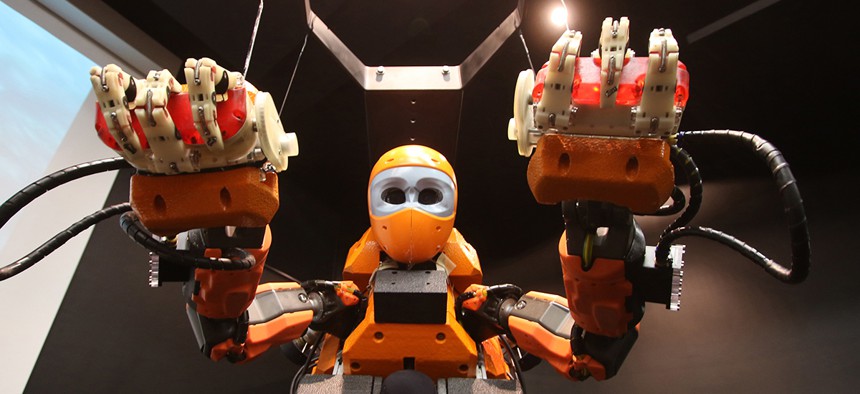This Robot Mermaid's Main Goal Is to Explore the Deep Sea

French officials show off "Ocean One" an underwater diving robot at the history museum in Marseille, southern France, Thursday, April 28, 2016. Claude Paris/AP
The OceanOne robot has successfully explored the wreckage of a ship that sank in 1664.
While we worry about a future where robots have taken all of our jobs, there are some we would gladly get rid of. Humans have to operate in so many dangerous situations—oil rigs, nuclear power plants, under water, fighting fires, to name a few—that a team of roboticists and computer scientists at Stanford are creating a future where we won’t have to.
Last week, they announced that their robot creation, OceanOne, had successfully explored the wreckage of the French ship La Lune, which sank in 1664, 100 m (328 ft) below the surface of the Mediterranean 20 miles off the coast of France. No human has touched the ship since it sank.
Oussama Khatib, a Stanford computer science professor who leads OceanOne, told Quartz that he’s been working on building and teaching robots to interact with the physical world for over a decade. Although the team has explored working with autonomous robots before, the goal with the OceanOne was different: The robot essentially acts as a proxy for humans in difficult-to-navigate situations.
“This is a project aimed at bringing the technology of robotics to spaces that are dangerous for humans,” Khatib said. “We know in those spaces it’s going to be very hard to create a completely autonomous system.”
OceanOne is operated by a set of controls that relay information from sensors on the robot. The sensor information allows the controls to provide haptic feedback, meaning they mimic our sense of touch. This allows the robot’s operator to essentially feel what the robot is feeling, and its onboard cameras the operator to see as the bot does. From a boat above the robot, Khatib got an immersive sense of the wrecked ship, and everything on board, as no one had for 352 years.
Most of today’s robots, Khatib said, work well enough in structured environments, but can’t perform as well as a human when the situation is unpredictable. Khatib’s bot leverages the strength and reliability of a robot with the dexterity and planning abilities of a skilled human.
Having successfully explored the wreck, OceanOne is enjoying some down time at a museum in Marseille, France. Khatib said that 2,000 people visited the robot April 30, marveling at a bot that looks like cross between a Transformer robot and an orange ninja.
Khatib’s team anthropomorphized the robot’s design, giving it a face and human-like arms, to make it adaptable for many roles.
“It is true if you have a specific task you can build a specific robot to do it,” he said, “but if you want versatility—if you want to operate in a human environment—humans are the best.” His research into “human-centered robotics” aims to create a general purpose robot.
For now, OceanOne will embark on more archeological dives, and Khatib will work on improving the bot’s hands and vision—there’s talk of exploring a Roman shipwreck. He wants to build more versions of the bot that could tackle similarly dangerous environments.
He suggested that Schlumberger and BP are interested in versions of the bot that could take on tricky tasks in oil fields, leaving the humans controlling the bots nestled away at a safe distance. Such bots could be used in many different dangerous situations.
“This is going to happen: We can have robots that can intervene in real time through experts,” Khatib said. “We want our robots to eventually become commercial and used by everyone.”
The robot will soon return to Stanford for refurbishment and upgrades before its next endeavor. For now, some rest: “The robot really likes France,” Khatib said.





